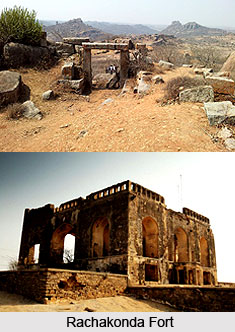 Rachakonda Fort is located in the Indian state of Telangana, a newly formed state in India.
Rachakonda Fort is located in the Indian state of Telangana, a newly formed state in India.
Location of Rachakonda Fort
Rachakonda Fort was built by Recherla Singama Nayak in the 14th century AD. Recherla Singama Nayak also developed and administered the region of Rachakonda or Rajaconda. The geographical coordinates are latitude 17 degree 176 minutes north to 10 minutes and 33 second South and longitude 78 degree 48 minutes 28 seconds east. Recherla Velama chieftains served as the rulers of Rachakonda. They belonged to the Padma Nayaka dynasty. The fort served as the capital of the kingdom of Rachakonda during the reign of the Recharla Padma Nayakas. After the decline of the Kakatiya Dynasty, the territory prospered and flourished. The fort of Rachakonda is situated almost 60 km away from Hyderabad, which is now the capital of Andhra Pradesh and Telangana.
History of Rachakonda Fort
The family reigned over the Telangana region in the pre-Bahamani era and the post-Kakatiya period in the Deccan. Rachakonda or Rajaconda was a small neutral state between two the rival empires of the Hindu Vijayanagar Empire and the Muslim Bahmani Sultanate. Eventually the Bahamani ruler captured the state in 1433 AD. Shitab Khan became the governor of Rachakonda in 1480 and served till 1485. Later in 1503, he announced his independence and occupied Rachakonda fort, Khammam fort and Warangal fort from 1503 to 1512. Later in 1498, Rachakonda came under the rule of Qutubul Mulk Dakhani who was the last governor of Telangana. Eventually the territory became a province (Jagir) of the rulers of the Qutab Shahi Dynasty.
Architecture of Rachakonda Fort
Rachakonda Fort is primarily influenced by medieval Hindu fort architecture. The structure is built with large stones of irregular size and shape. Moreover, the entire fortress is constructed without the use of mortar. The entrance gates have stone pillars and horizontal beams. The exterior walls of the building are built with stones and the interiors are layered with mud. The structure of Rachakonda Fort was strategically developed as a defensive bastion with strong fortifications. It was one of the most prominent structures during the pre-firearms era.
Rachakonda Fort was constructed in accordance with the Vastu Shastra by sage Maamuni Mayan (Vishvakarman). The fortress was built with upper tier and lower tier and the town was located towards the south east direction of the fort. There are several ancient temples in the vicinity as well. Presently, the fortress is in a ruined state and is managed by the Government of India.



















